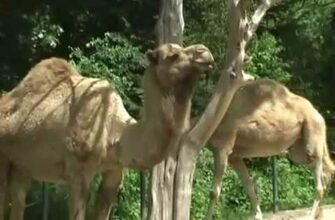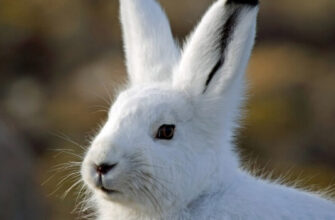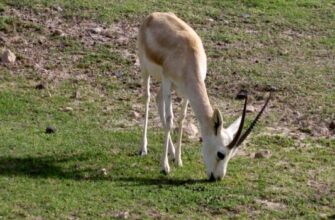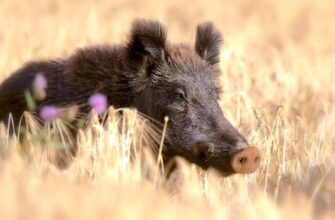The vole mouse is a constant companion of mankind. Due to the fact that these small animals carry many dangerous diseases and harm agricultural plantings, people consider mice to be their enemies. At the same time, in folk art you can often find a mouse — a fabulous assistant, a faithful companion in business.
This material is about a field mouse, a small and charming animal that plays a crucial role in the functioning of ecosystems over vast territories, in a wide variety of natural conditions.
The origin of the species and description
The vole mouse, as the field mouse (Apodemus agrarius) is often called mammals, belongs to the genus Forest and field mice, which is part of the Mouse family, belonging to the order Rodents.
Animals are endowed with all the main features of the Rodent order:
- They have upper and lower pairs of incisors that constantly grow and do not have roots;
- Consume plant foods;
- Have a long caecum;
- Early puberty;
- Have a high fecundity, bring several litters per year.
Appearance and Features
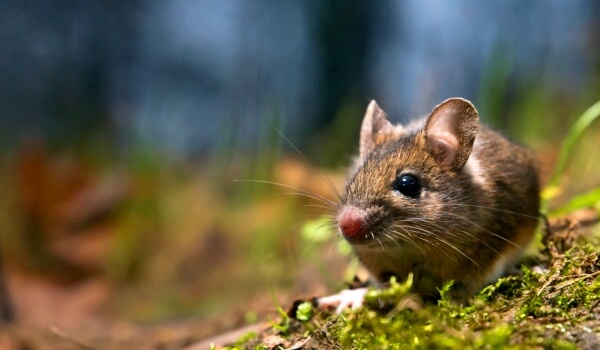
Photo: Mouse vole
Field mouse — relatively small animal, has an elongated body 10-13 cm long, the tail is slightly shorter and makes up to 70% of the body length. Mice have short and hard fur, which is usually painted gray, brown or red on the back, there are motley and striped individuals. The fur along the spine is colored black in the form of a strip («strap») running from the neck to the base of the tail. The fur on the abdomen is usually lighter, painted in gray tones.
On a pointed blunt muzzle (2.1 — 2.9 cm in size) there are small black eyes and semicircular short ears, which determine the excellent hearing of rodents. Sensitive whiskers grow around the nose, which give mice the ability to perfectly navigate the environment even in the dark. Mice do not have cheek pouches that are common to many rodent species. For field mice. unlike other representatives of the genus Apodemis, a special structure of the skull is characteristic. Mice have short legs with five toes.
Video: Vole Mouse
The fingers have short, blunt claws from constant digging. The hind feet are elongated, protrude forward when moving and have a size of about 2.5 cm. The tail is long, reaches up to 9 cm, on the surface there are keratinized skin scales with sparse hairs.
Where does the field mouse live?
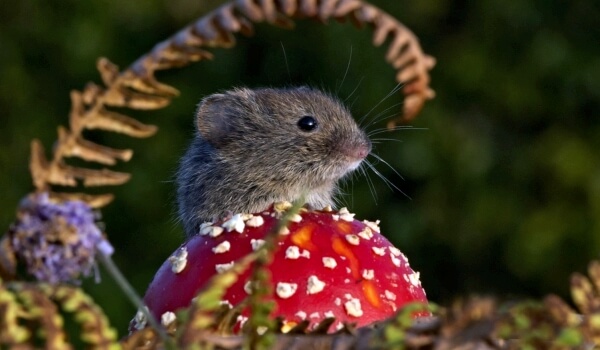
Photo: Mouse vole animal
There are two large areas in the habitat of voles: European & # 8212; Siberian-Kazakhstan and Far East — Chinese. The first region (western) is located from Central Europe to Baikal, the second region of the range — from the Amur to the Chinese Yangtze. In Transbaikalia, there is a gap in the range. The range of the field mouse is formed under the influence of many factors, the most important — features of vegetation and the impact of human activities.
Another limiting factor in the distribution of — moisture, so natural habitat — territories adjacent to rivers and lakes, having swampy areas with diverse vegetation and nearby meadows, meadow steppes, separately growing shrubs, moist edges, clearings, deciduous and mixed coniferous-deciduous forests.
Samaya a large population is located in the forest zone of the northern part of the range, where the amount of precipitation per year is in the range of 500 – 700 mm. In forests and steppes (less than 500 rainfall), field mice are less comfortable, so they inhabit lower, wetter landforms.
The size of the habitats of individual individuals in mice is huge for such a small animal — ; up to several tens of thousands of square meters.
Usually, mice dig simple and shallow burrows (up to 10 cm deep), of a simple structure, they consist of one or two chambers with 3-4 inlets. In places with a complex microrelief, mice can dig complex burrows up to 7 m long, in which a colony of animals settles. When living in flooded lowlands, where it is impossible to dig a hole, field mice build nests on bushes in the form of balls, which are adjacent to grass paths.
Under adverse conditions, unsuitable for existence, mice are able to migrate several kilometers. Field mice often visit landfills and garbage dumps of settlements. The conditions of the city are favorable for the life of field mice, but they avoid human dwellings. They can be found in sparsely populated parts of the city in the basements of houses and in deserted warehouses.
What does a vole mouse eat?
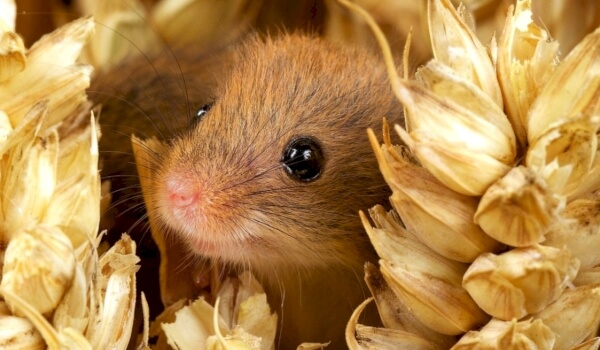
Photo: Field mouse
The vole is a typical herbivorous rodent, its incisors grow throughout its life. Appearing at the 2nd month of the life of mice, they grow by 1-2 mm every day. To prevent oversized teeth, rodents must grind them down constantly. To do this, animals bite inedible solid objects that surround them.
The mouse eats any available plant food:
- Fruits (berries, seeds);
- Aerial parts of plants (leaves, stems, buds);
- Underground parts of plants (root crops, succulent roots, sweet tubers, bulbs);
- Delicate young bark of broad-leaved trees and berry bushes.
Seeds predominate in the diet of voles, but field mice eat a lot of green food (especially leaves and stems of plants), more than other rodents. Mice do not refuse to eat animal food (insects, caterpillar larvae, beetles, earthworms), which is also present in the diet. Willingly consume products (grain, cereals, legumes, flour, vegetables, fruits, bakery products, meat, lard, sausage) found in a person’s dwelling.
In total, during the day, an adult field mouse should eat food and drink liquids in an amount equal to its own weight (5 g of dry food and 20 ml of liquid). With a lack of water, the animal receives it from the succulent parts of plants. The field mouse accumulates up to 3 kg of winter food stocks, as the little toiler begins to stock up from the middle of summer. During the winter period, it eats everything that it managed to stock up in a hole during the warm season.
Peculiarities of character and lifestyle
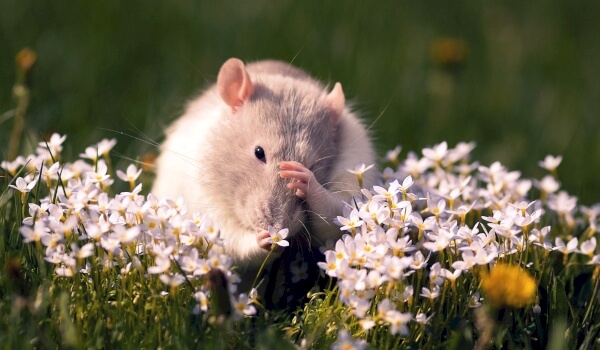
Photo: Vole mouse in nature
Field mice are fussy and voracious creatures. The body temperature of the mouse ranges from 37.5°C to 39°C. In order to maintain it, animals need to be active around the clock and all year round and consume a lot of food. If the mouse stops moving in winter — it will freeze if it stops moving in the summer — may die from excess heat. All mouse life is in motion — obtaining food, food, mating games, the birth of offspring and caring for him.
Daily activity varies throughout the year: in summer — night time, autumn — day and night, in winter, daytime activity will increase. In conditions of lack of food and deterioration of living conditions, at the beginning of the cold season, mice migrate to more comfortable conditions, often approaching human habitation, and return in the spring.
For effective protection, food production and raising offspring, field mice live in groups . In a flock of mice there is a main male — a leader who maintains order and determines the time of rest and wakefulness. Weaker individuals try to behave as quietly and imperceptibly as possible, activity depends on what place the animal occupies in the structure of the group.
Female mice are calm and peaceful, while males periodically try to dislodge the leader. Disgruntled behavior can be identified by the stomping of the hind legs and hard hitting the ground with the tail. Sometimes clashes within a group can lead to the disintegration of a pack, with the subsequent formation of a new one.
The burrows of individual mice are connected by treadmills, thus forming a settlement consisting of 20 — 40 holes and more. In the spring, the paths go under the surface of the earth, when the grass grows and shelters from predators, the mice use the ground paths. After harvesting, ground movement becomes unsafe and they return underground. On agricultural fields, large colonies are formed with a complex network of underground and ground passages.
Field mice are active in winter, they hide from the cold and enemies under the snow cover, moving around and using their food supplies. It should be noted that contrary to the prevailing opinion about the cowardice of mice, the animal will protect its offspring and home even from an animal that is many times larger than itself.
Social structure and reproduction
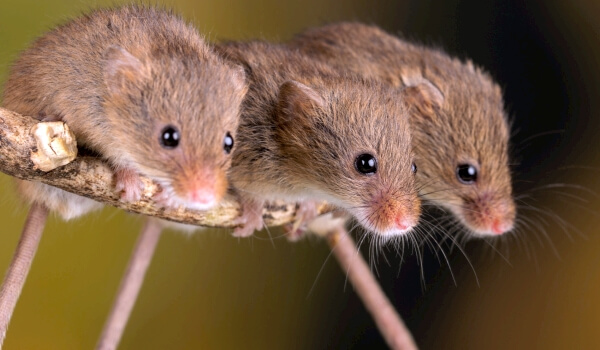
Photo: Field Mouse Cubs
Field mice are very prolific, like all rodents. In females, puberty occurs at 3 months, she becomes capable of conception and the birth of cubs. In sexually mature mice, estrus begins, which lasts 5 days and is expressed by characteristic behavior.
Males mature a little later. Mice are polygamous; in nature, a male can cover from 2 to 12 females. If the coating does not end with pregnancy, the female will go into heat again within a week.
If fertilization was successful, on average, after 22 days, at night, the mouse gives birth. In each litter — from 3 to 12 cubs. Naked, toothless and blind helpless mice are born, ranging in size from 2 to 3 cm.
The mouse feeds its children with milk for about a month, mouse babies grow and develop very quickly:
- on the 3rd day of life, fluff will grow on their body;
- on the 5th day, the mice can hear;
- on the 7th day, the body weight of the babies doubles;
- by 10 for days, the body is covered with full-fledged hair;
- eyes erupt in 2 weeks;
- after 19 days, the mice eat themselves;
- on the 25th day, the body length reaches 5 cm (the tail is shorter than that of an adult animal), the mice are able to live independently.
For a year, depending on the habitat, mice can give from 3 to 8 litters. Reproduction of wild mice in natural conditions occurs exclusively in the warm seasons. In winter, even in stacks and stacks of hay and straw, mice practically do not breed. Mice nestled in heated human dwellings breed all year round.
Under favorable environmental conditions, the population grows rapidly. On average, wild field mice live from one to one and a half years. In a human dwelling, some individuals live up to 7-12 years.
Natural enemies of vole mice
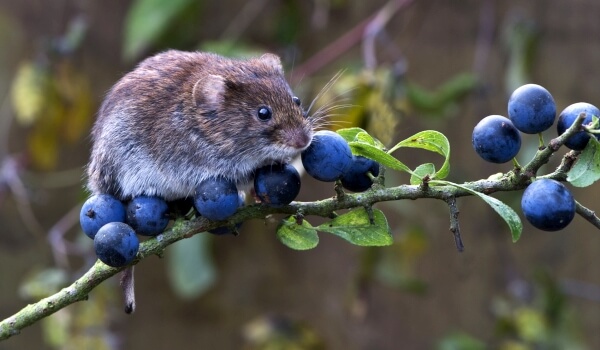
Photo: Vole Mouse
In nature, mice have a huge number of enemies that regulate the size of their population. Mice are the favorite food of birds of prey. Owls, owls, eagles, hawks and other predators actively hunt mice. For example, an adult owl can eat more than 1000 animals in a year.
For many mammals (badger, wolf, fox, marten, weasel, ferret), mice are the main, often exceptional food. For a day, an adult ferret catches and eats up to 12 mice. Weasel is extremely dangerous for rodents, as it has a narrow body that can bend and penetrate mouse holes, exterminating small cubs.
With pleasure they eat voles and reptiles (snakes and large lizards), hedgehogs, and, of course, the most famous mouse hunter, the cat.
Population and species status
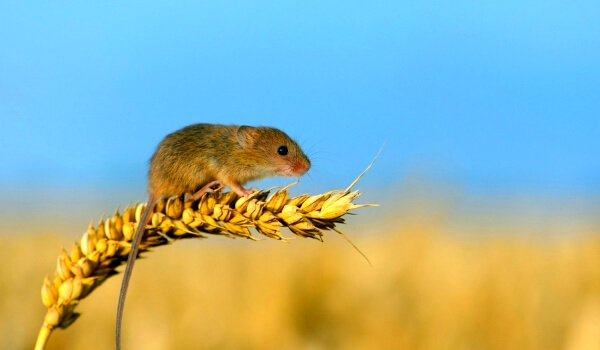
Photo: Mouse vole animal
The species of field mice is very diverse, about 60 different subspecies are officially described. Often, they are very difficult to distinguish in appearance; gene analysis is required for identification. At the same time, the mice themselves remarkably distinguish between individuals from another population and do not mate with them. How this happens and what mechanisms are used is still unknown.
The population of field mice depends on the year and season. Demographic rise and fall is noted every 3-5 years. The maximum population density was 2000 individuals per 1 hectare, the minimum – 100. Previously, it was believed that the reasons that determine the nature of the change in the population of mice are mainly exogenous factors: weather, pressure of natural enemies, the influence of infections.
Modern researches, without giving up the reasons listed earlier, point to endogenous factors, or process of self-regulation of population. In particular, the humoral mechanism plays an important role.
There is no threat of extinction for field mice. Apodemus agrarius is classified as «Least Concern» according to the IUCN Red List Categories and Criteria. The vole mouse can carry some very serious diseases that affect humans and can be fatal (tularemia, typhus, hemorrhagic fever with renal syndrome, leptospirosis, toxoplasmosis, salmonellosis, and some others).
The fact that voles carry diseases, and given the damage they cause to agricultural producers, leads to the fact that field mice are actively exterminated.
In the ongoing fight against rodents, we must not forget that field mice occupy their characteristic place in the ecosystem. Mice are the main food element of many game animals. By eating plant seeds, they regulate their species diversity and abundance.
The reason that the vole mouse often comes to human dwellings and agricultural plantings is a decrease in the area of their natural range, which is largely due to human economic activity and urban sprawl .

